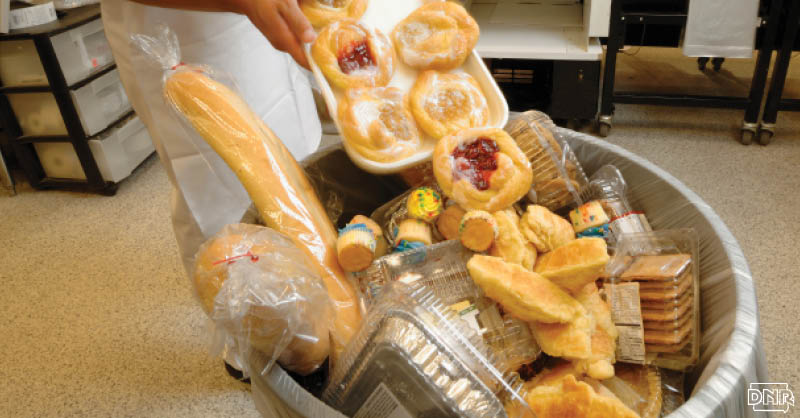Your parents told you to clean your plate for a good reason – Iowans send more than 190,000 tons of unopened, untouched food to the landfill. That’s enough to fill a line of dump trucks from Waterloo to Cedar Rapids.
Of all the trash sent to Iowa landfills, 20 percent – or 568,197 tons – is food waste. The average Iowan wastes about 30 pounds of food each month, according to the 2017 Statewide Waste Characterization study, even while one in eight Iowans is considered “food insecure.”
Waste is the key word – by reducing the food you throw away, you’ll save money on fewer groceries – up to $2,000 a year. It also keeps food from taking up unnecessary room in landfills and helps conserve the resources needed to grow, process, transport and sell food.
Here are some simple steps to help reduce food waste:
 Buy only what you need.
Buy only what you need.
Sure, bananas are on sale for a quarter a pound, but can you really eat 5 bunches of bananas before they go bad? Unless it’s a staple you’ll know you can eat or store for the long haul, like in the freezer, avoid overstocking up on something just because it’s on sale. But if you do buy too much, consider using overripe fruit, like bananas, in banana bread rather than throwing them away. Also keep in mind that some stores sell misshapen, slightly bruised or otherwise “ugly” produce at a discount, making it a perfect way to save money while cooking and baking.
Over buy on a new food that wasn’t all you thought it would be? Consider donating the rest to a local food pantry.
Plan ahead.
Make a list and stick to it to avoid impulse purchases that may end up going unused. Be even more efficient by planning your meals for the week and buying only the ingredients you need for those meals. Check the fridge for ideas for using up what’s already in your fridge before heading to the store.
Get creative with leftovers.
Find new recipes to give leftovers new life, like using up the Thanksgiving turkey in turkey noodle soup, or leftover meat and veggies for “kitchen sink” pizza or stir fry. Or, freeze leftovers in single portions and have a quick lunch ready to go on hectic days.
Be chill.
Understand your fridge’s and freezer’s settings to make sure foods are kept at a safe temperature – below 40 degrees in the fridge and zero in the freezer. Know how to store individual fresh fruits and veggies to get the most life possible, or consider frozen foods if you want some always on hand. Keep in mind that the door is the warmest spot in the fridge, so keep eggs in their carton at the back on the fridge. Be sure to not over-stuff your fridge to allow for air movement.
Cut the clutter.
Avoid the “mystery leftover” covered in fuzz at the back of the fridge by keeping your food organized. Keep leftovers labeled with contents and date, and rotate the oldest food to the front so it gets used up first. The same goes for the pantry and cupboards – make things easy to find and hard to bury.
About that cleaning your plate part…
Only put on your plate what you know you’ll eat. Start with a small serving and go back for more if you’re still hungry, rather than leaving uneaten food on your plate.
Learn how to freeze and preserve.
Sure, lasagna was great the first three nights, but if you’ve had enough, don’t let the rest languish in the fridge. Learn the best techniques for freezing different foods, and be sure to label containers clearly, as it often gets difficult to see the contents after it freezes. For pantry foods, keeping chips and crackers in air-tight containers rather than their original packaging can help them stay fresher longer.
Take it to go.
Don’t waste what’s left on your plate when you go out to eat – ask for a to-go box and you’ll have one less meal to prepare at home. Or, if you’re traveling, search for menu items with smaller portions or share a dish with a friend.
Compost what’s left.
Sometimes, things just mold before we expect them to. Or you have cores and peels. Consider starting your own home compost bin with our tutorial.
For more ideas, check out our Earth Day Every Day and In Your Own Backyard boards on Pinterest.
